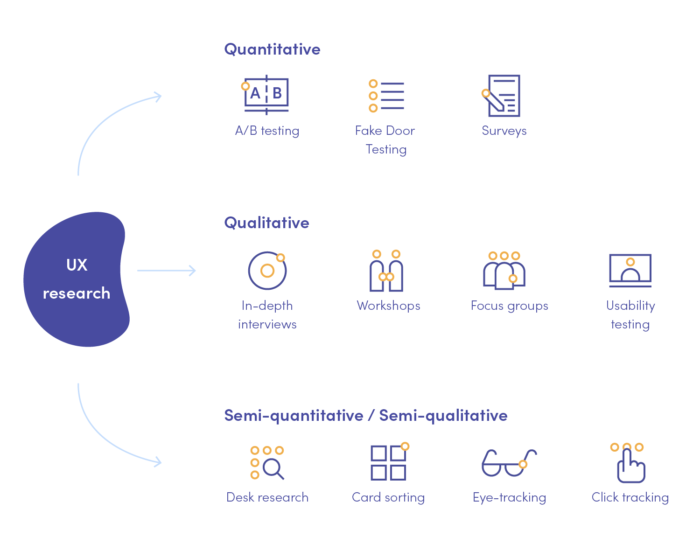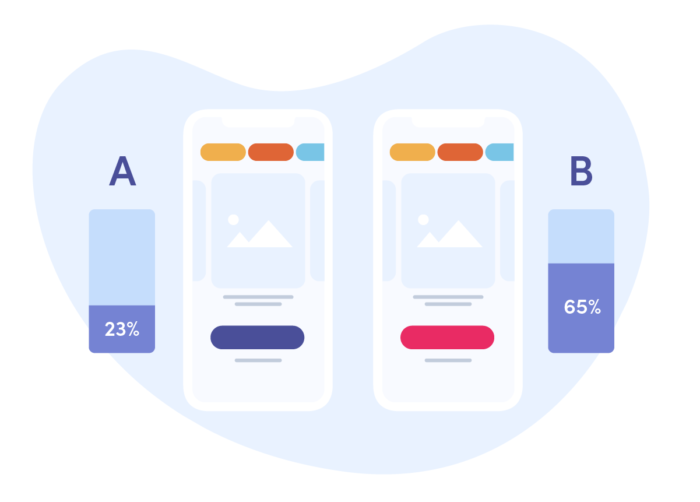Want to gain a deep understanding of your end-users’ needs, challenges, expectations, and limitations? Or maybe you want to introduce some improvements to the already-existing product? It’s high time to do thorough research!
In this article, I’ll tell you everything you need to know about UX research and present the 11 UX major research methods. With their help, you will create a successful user-oriented product that will elevate your business!
But first…
What exactly is UX research?
UX research is one of the core fields in the User Experience design process. It focuses on examining users and analysing the market or competitors.
By applying numerous quantitative and qualitative methods, researchers gather valuable insights about the end-users to later apply them in the design process.
UX research helps you understand your potential users better and discover their needs, fears, pain points, and reliefs. It’s also the right tool for you if you’d like to test users and see how they interact with your product: what irritates them or causes difficulties, etc.
Is UX research really important for your business?
Many companies, especially startups, don’t consider UX research a crucial part of the product development process. It seems to them that doing research consumes lots of time and money and serves no purpose. Then they release the product and discover that it is a complete failure: hardly anyone downloads their app, and the user retention rate remains at 1-3%.
How could this happen? They had a great business idea, so what could go wrong? Well, if they had done in-depth UX design audit, they might have found out.
So remember that even the boldest business ideas require detailed research (including various R&D solutions) and analysis. It’s the only way to find out what users need and how to meet their expectations.
The importance of UX research
UX research is essential for a number of reasons:
- With UX research, you gain a broader overview of current market demands and competitor activities to adjust your digital product to them.
- It allows you to gather more insights about your potential end-users: their needs, problems or pain points.
- In-depth UX research can prevent you from investing money and time on unnecessary features.
- With UX research, you can make more data-based decisions on how the product should develop.
- Through various research methods, you can pinpoint which elements of your digital product require improvement.
- You can make important changes to a digital product before it even hits the market.
Applying UX research in business: an example
Suppose you have a fresh business idea and want to build an onboarding app for remote employees. After all, in the COVID pandemic era, more and more companies offer remote job positions, so such an application seems like a gold mine, right?
But how do you know that? Are you 100% positive that there is a strong market demand for such a solution? Or maybe onboarding applications for remote employees already exist, and building a similar thing will be a waste of money that will cause a financial fiasco? And even if not, what features do users expect to find in this app? How do you respond to their needs? The more questions you raise, the more unknowns you uncover.
That’s where UX research comes to the rescue. Conduct comprehensive market research and competitive analysis, talk to some experts and, most importantly, carry out user research. Find out what end-users have to say, what features they would need, how your digital product can improve their lives, etc.
So if you’re still wondering if UX research is vital for business sake, let me assure you: it really is important, and you should never skip it.
In this article I will focus heavily on user research, leaving the market and competitive analysis for some other time. Why? Because “It all starts with the user”!

Best quantitative UX research methods
With quantitative research methods, you can collect and analyse statistically relevant data about the end-users. Here, you’ll find out ‘how much’, ‘how many’ or ‘how often’ rather than ‘how’. Quantitative data is usually relatively easy to collect, as you have plenty of analytical tools (such as Google Analytics) at your disposal.
Researchers often choose quantitative methods as they bring many benefits, such as:
- possibility to avoid cognitive biases
- easy graphical data presentation in various diagrams or charts
- clear visualisation of user habits and trends
- stakeholders and investors just love numbers.
Sometimes even a minor change can make the difference, and A/B testing proves that.
You can conduct A/B tests on already existing digital products. This method involves performing a kind of experiment: you create two similar versions of a variable (it could be a button, a micro-copy or even a colour change), and then you show both versions to users. After a while, you can compare which version performs better. Importantly, you should test only one variable at a time to avoid chaos during your analysis, otherwise, it would be quite challenging to determine which shift resulted in better performance.

Fake door tests are a great way to test users’ interest in a feature, product or service. This method involves visually placing an option and counting how many people have clicked on it.
Let’s see how this works in practice. Suppose you have an online shop and are considering expanding into some foreign markets. Which market to choose? You can place a language switcher and count how many people have chosen the French, Italian or Spanish language version.
But that’s just an example. You can test different CTA buttons, in-app notifications or pop-ups. However, remember to conduct fake door tests carefully! After all, you probably don’t intend to annoy users with non-stop invitations to products or features that aren’t actually there.
I’m sure you more or less know what surveys are all about. But here’s a quick recap: online surveys contain a list of questions (either open-ended or close-ended) that you send to your target group to receive more detailed topic-specific information.
This UX research method is relatively easy, quick and cheap, and, importantly, can be successfully carried out remotely. All you need is Google Forms, a list of questions, a statistically relevant contact database, and you’re all set.
Best qualitative UX research methods
Qualitative research methods are another matter altogether. Here, you don’t obtain numerical data. Instead, you analyse the behaviour, feelings, opinions or motivations of specific users. If you want to dive a little deeper to discover ‘why’, qualitative methods are the best way to do that.
It’s worth incorporating qualitative methods into your UX research for a few solid reasons:
- It gives a better understanding of the users: their fears, motivations, pain reliefs.
- It helps to explain the data obtained from quantitative analysis.
- Qualitative methods work great at every stage of the design process.
This is one of the most common user research methods for gathering qualitative data. With in-depth interviews, you conduct a series of face-to-face conversations with a target group. These conversations are designed to gain detailed insight from users and learn about their opinions, behaviours and experiences.
IDIs bring many benefits: with their help, you can get honest customer feedback, better understand your end-users and their main difficulties, and gather rich data with only a few interviews. Also, in-depth user interviews can be conducted either in person or remotely (mostly by phone or video call).
So if you want to find out what users feel about a product you’ve just released, or to collect data to build customer personas, or you want to know what needs improvement – that’s what IDIs are for.
You have several types of IDIs to choose from:
- Structured: the researcher follows the agenda rigidly and asks only pre-determined questions.
- Semi-structured: the researcher follows the agenda but can modify the questions and their order throughout the interview.
- Unstructured: The researcher doesn’t stick to the agenda and attempts to conduct a more natural conversation with the participant.
- Dyadic: The interview is conducted with two participants presenting similar (homogeneous) or opposite (heterogeneous) opinions, points of view or characteristics.
This is another great qualitative method that you can successfully employ as a valuable source of information about user needs.
In a typical focus group, you moderate a discussion on a specific topic with a group of 6 to 9 people encouraging them to share their honest thoughts and opinions. Also, usually this method doesn’t end just with one meeting – you should organise a series of discussions with several focus groups to explore different audiences. This way, you’ll have a better understanding of your users’ choices and preferences, allowing you to design your digital product accordingly.
Focus groups are great for examining your audience’s needs, getting different points of view from end-users and learning more about solutions developed by your competitors.
This method involves asking participants to perform specific pre-planned tasks on a product prototype.
Usability testing is a great way to check if the product is intuitive and if users can find all the relevant information. It’s also a great iterative approach that lets you plan further modifications and improvements.
How does this work in practice? Let’s say you want to check if a new feature is functional, easy to navigate and if everything there is crystal clear. For this purpose, you create several tasks for users to complete an action with this feature and ask them to think aloud as they perform it. If they completed all the tasks without any hassle, it’s a clear sign that your product is easy to use and intuitive. However, if you have noticed some struggles, it means that something still needs to be improved.
Here’s a step-by-step summary of how to conduct moderated usability tests successfully:

Want to learn more about this method? Be sure to check our guide to usability testing!
Workshops are pre-planned meetings, usually with clients (although you could just as well run workshops with users or your design team), meant to solve problems, develop product strategy, build prototypes, or get valuable business insights.
As a UX researcher, you conduct different exercises and activities to generate fresh ideas and achieve tangible goals during product design workshops. Such meetings stimulate the progress of the whole design process and help set the direction for developing a digital product.
Best semi-quantitative / semi-qualitative UX research methods
So you’ve already got your qualitative and quantitative methods picked out, and you want to take on user research. But hold on!
There is another group of methods that you can choose for your UX research, the one that combines quantitative and qualitative studies. With them, you’ll collect a wealth of statistical data, and on top of that, you’ll have the opportunity to test particular users in their natural environment. All at once!
Do you remember the times when you had to write your MA thesis or a college essay for a particularly demanding professor? I bet you do. So you probably know that one of the first things to do is a literature review where you gather all the necessary information and get more topic-specific insights. And this is more or less what desk research is all about.
Before you even get down to selecting features of your product and creating beautiful prototypes, you need to sit down and take some time to do a general overview.
During desk research, look at already existing products, read about your competitors and how they managed to conquer the market. Or perhaps you will find some useful statistics, industry reports or interesting facts? It’s also a great source of information!
Things look a bit different when you do UX research for a product that already exists. In this case, you can dig a little deeper into the company: ask about their past reports, iterations, A/B tests and anything else that might bring some valuable insights.
With this research method, you can:
- gain an initial market overview
- identify your major competitors and check what solutions they have implemented
- get interesting facts and statistics to help you define your target audience.
Want to improve your product’s information architecture? Card sorting will certainly do the trick.
This widely popular user research method involves grouping various labels according to what seems most accurate to participants.
How does this work in practice? Let’s assume you want to open an online book store. How would you categorise your assortment so that users can easily find the perfect book? To learn how to organise the information correctly and use understandable terms, you can carry out card sorting with users. Prepare cards with different terms (1 card = 1 term) and ask participants to categorise them according to their preferences.
You can implement card sorting to your UX research for several reasons:
- to understand how users organise information
- to check whether the terminology used in the product is correct and understandable
- to verify information architecture
- to create intuitive navigation

Eye-tracking is a research methodology successfully applied in numerous fields. It should also come as no surprise that, over time, eye tracking has become adopted by UX researchers for usability testing.
This methodology involves recording the participants’ eye movements and analysing where they are looking, for how long, and what elements their gaze is focused on when interacting with a digital product.
Thanks to eye-tracking, you can examine participants’ subconscious behaviour, check which user interface elements draw their attention, collect unbiased and highly precise data and complement it with other biometric data (EEG, EMG, etc.) So if you want to test your product for sales or marketing, choose eye-tracking!
Last but not least…
Click tracking is a research method that allows you to track, as the name suggests, where users are clicking on your website, app or email.
Various tools (such as Hotjar) record clicks on desktops and taps on mobile devices and then generate helpful reports. There you will gain numerical data (e.g. the number of clicks on a button), as well as heat maps or recordings from specific sessions.
If you want to test how to increase conversions, identify the product’s strengths and weaknesses, and analyse real user behaviour, click tracking will undoubtedly help you!
Top user research methods: final thoughts
In this article, I have presented the top 11 UX research techniques. Of course, the list doesn’t end here. Depending on your needs, you can also choose other highly effective techniques to give you detailed insights into your users. These can be:
- Net Promoter Score (NPS)
- Quasi-experiments
- Custom Satisfaction Score (CSAT)
- Conversion path analysis
- Tree testing
- Diary studies
- Observations
- And so much more!
The main lesson from this article is this: if you want your digital product to truly work and captivate users, you can never neglect the importance of UX research.
We will build a research-based and user-oriented digital product for your business – choose our UX design consulting services!
How does UX research help businesses?
You can use UX research in your business for many different reasons:
- Through in-depth user research, you can better personalise your digital solution to user needs, thus increasing their engagement and retention.
- By conducting market research and competitor analysis, you can better prioritise which features are most necessary.
- UX helps reduce the cost of customer acquisition.
- You can use UX research to support your business decisions regarding product development and marketing campaigns.
How do you choose the right UX research method?
If you want to gain as many useful insights as possible, you need to choose the right UX research method. For this purpose, you should ask yourself a few questions first:
- What don’t I know yet but need to find out?
- What is the main goal of my research?
- What data do I need to collect?
- Do I want to learn about user behaviour or their opinions?
- At what stage of product development do I want to conduct the research?
With their help, you will make some things clear and will be able to set the direction of your UX research.
Here are some additional tips to help you make the right choice:
- If you need statistically relevant data, conduct quantitative research with a larger sample group.
- If you want to hear user feedback, conduct qualitative research, whereas quantitative methods will be the best solution to study user behaviour.
- Some UX research methods, such as A/B testing, can’t be applied before a product is released.






